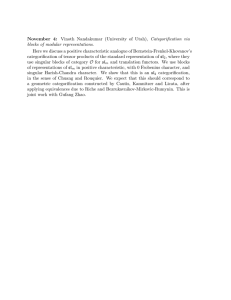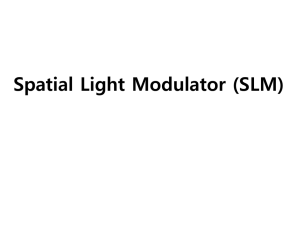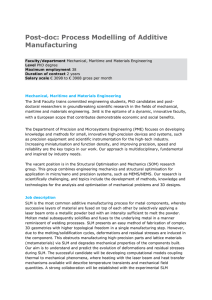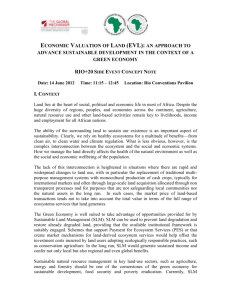Global Mechanism: Incentives and Market based Mechanisms
advertisement
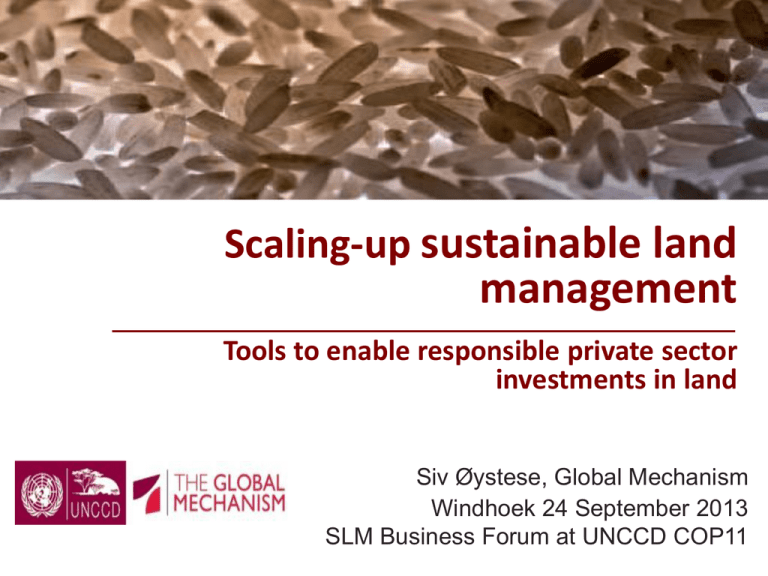
Scaling-up sustainable land management Tools to enable responsible private sector investments in land Siv Øystese, Global Mechanism Windhoek 24 September 2013 SLM Business Forum at UNCCD COP11 THE PRIVATE SECTOR & LAND Private sector: • a major user of and investor in land that can and should play a key role in managing land resources • A diverse group from a range of sectors: agriculture, energy, forest, water, tourism, extractive industries... How to unlock the potential for private sector investments in sustainable land management? How to scale up good practices? PROVIDING ECONOMIC EVIDENCE The science of valuing ecosystem services (ES) can inform private sector decision making by: – making the business case for SLM investment options by providing the total value of land – recognising and measuring the value of ES, create markets for ES that gives economic incentives for investments and adoption of SLM PROVIDE THE RIGTH INCENTIVES & MARKET BASED MECHANISMS • Often a mismatch between stakeholders paying the costs of maintaining land resources (e.g. opportunity cost of not converting a forest to cropland) and beneficiaries (e.g. downstream water users benefiting from the regulation of water flows). • There are a range of incentives and market-based mechanisms that can: – encourage companies, communities and other private land users to adopt and invest in SLM; and – enable the land users to cover the cost of adopting sustainable practices Framework and score card tool developed by GM and CATIE on incentive & market based mechanisms Studies at national and sub-regional level: including Cambodia, Cameroon, Dominican Republic, Guatemala, Mozambique, Panama, Tanzania, Zambia & South East Asia Best practices and case studies http://global-mechanism.org/gmpublications/view-category responses Framework: 14 incentive and market based mechanisms Type Mechanisms 1. Public payment schemes A. Permanent conservation easements B. Contract farmland set-asides C. Co finance investments D. Payment for proven investments in SLM E. Subsidies F. Tax, tax breaks, environmental fees 2. Open trading under regulatory cap or floor G. Conservation banks H. Tradable development rights I. Trading of emission reductions 3. Self organized private deals J. Purchase of development rights K. Direct payments for ecosystem services L. Conservation concessions 4. Eco-labeling of products and M. Marketing labels N. Certification schemes services example 2: Payments for ecosystem services in Tanzania Objective: Decrease soil erosion and overall land degradation lowering the quality of the water of the Ruvu River Coca Cola and public water company – willing to pay upstream farmers for implementing SLM practices because it reduces their water treatment costs CARE responsible for training and monitoring example 3: Grandis Timber teak plantation & Forest Stewardship Council® certification • Study on land use change in Cambodia for Ministry of Agriculture: 1. Making the case for sustainable land management: CBA of land use change - Ecosystem valuation methods 2. Potential for using incentive and market based mechanisms - FSC labelling & Grandis Timber teak plantation • • • • cont. example 3: Grandis Timber teak plantation & Forest Stewardship Council® label 10,000 ha Economic Land Concession Degraded land (previously clear cut) Land restoration and biodiversity area Costs: – Reduced production (20% set aside for biodiversity and land restoration) – Initial accreditation (US$ 50k) + annual audit (US$ 30k) • Benefits: – No price premium, but access to bigger markets – Investor demand - the FSC label has attracted finance that would otherwise not be accessible Scaling up – what does it take? www.capacitybuildingoslo.com • Raise awareness on opportunities • Value ecosystem services and natural capital • Monitor to demonstrate returns on investment and make the business case for action • Clear and reliable policies and regulations establishing a level playing field and conducive business and investment climate • Champions are needed! Thank you! Siv Øystese Coordinator, Economic Instruments and Innovative Finance Global Mechanism of the UNCCD s.oystese@global-mechanism.org example 1: Eco-labeling of products and services in Zambia COMACO: Community Markets for Conservation Objective: reduce poverty and hunger whilst conserving environment Poor, food insecure farmers are organized into producer groups, trained in quality, legal and income-generating skills focused on sustainable agriculture Sustainable land use practices qualify the farmer for conservation dividends COMACO purchases surplus crops and resells them as processed, value-added, organic products under the brand IT`S WILD!
